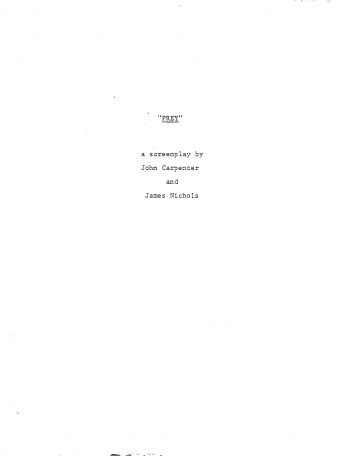 By JOHN CARPENTER, JAMES NICHOLS (197?)
By JOHN CARPENTER, JAMES NICHOLS (197?)
Among unmade John Carpenter screenplays PREY, a 98 page script hailing from the mid-1970s, is about average. Co-written with Carpenter’s pal James Nichols, a fellow USC alumni and the second unit director on ASSAULT ON PRECINCT 13, it was intended as a directorial vehicle for the late Bob Clark, following his proto-slasher hit BLACK CHRISTMAS (never mind that Carpenter has publicly dismissed the latter film, telling a Vanity Fair interviewer “I remember coming out of BLACK CHRISTMAS thinking, ‘I don’t know about that’”). The movie was never made, but in script form PREY has proven quite influential on Carpenter’s subsequent filmography.
Its protagonists are three Washington, D.C. based physical fitness obsessed women—TV newsreader Elaine and her housefrow friends Rose and Kathy (described in superlatives that include “her features are cool and sculptured like those of an actress,” and take into account their “long, graceful legs”)—who decide to climb a mountain in the Great Smokey range in the hope of setting a hiking record. That these women are well equipped for the sure-to-follow horrors is indicated by an early passage showing that Rose is a well-trained archer, and another that details a “super flare” the gals carry. Of course they’re cautioned by a local that “Raymond’s daddy said he seen things back up in there…Strange kind of things,” but of course the ladies disregard that warning.
There is indeed strangeness ahead, in the form of Swain, a “six feet tall, thin, old, cadaverous” individual whose “giant, 6’7” brother Luke, “about 280 pound” father Otis and gruff matriarch Grandma are the last remnants of a southern family who hid out in the woods after the Civil War. They abduct the ladies for reasons that are never made entirely clear, leading to a lengthy succession of pursuit and capture, spiced with plenty of gore and brutality.
As far as city slickers-going-up-against-psychotic rednecks stories go, PREY can’t be said to approach THE TEXAS CHAINSAW MASSACRE, THE HILLS HAVE EYES or even DELIVERANCE (which would appear to be the script’s chief inspiration). The antagonists aren’t particularly well developed, and the horrific action that fuels the script’s second half isn’t strong enough (at least by 21st century standards) to be held against that of its predecessors. The feminist angle at least seems sincere (never mind that a great deal of nudity on the part its leading ladies is specified), and the fact that the slasher movie conventions Carpenter helped usher in hadn’t yet been established makes for some engagingly quirky storytelling and descriptions. Hence, I’ll give this script a C+.
